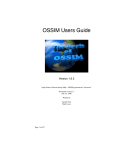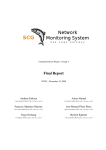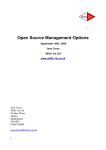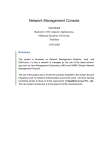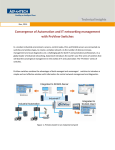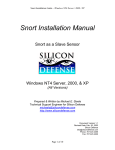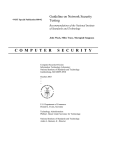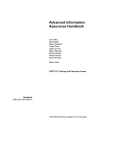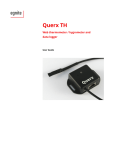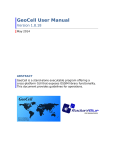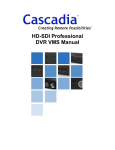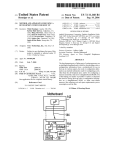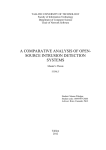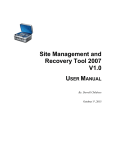Download O S S I M Open Source Security Information Manager
Transcript
OSSIM Open Source Security Information Manager User Manual Created by Kevin Milne (www.z4ck.org) Contributions by OSSIM Staff 2nd September 2004 Index Introduction 3 1 Logging in 5 1.1 The Metrics Screen 5 2 The Policy menu 5 2.1 2.2 2.3 2.4 2.5 Creating a new sensor Defining signature groups Creating a network Adding a group of relevant ports Editing the priority and reliability 6 7-8 8-9 9-10 10-11 2.6 Creating a host 2.6.1 Updating the host information 2.6.2 Alarms and alerts 2.6.3 Alerts 2.6.4 Using the ACID console 2.6.5 Vulnerabilities 2.6.6 Host Usage 2.6.7 Anomalies 11-12 12-13 13 14 14-15 15-16 16 17 2.7 Creating a policy 17 3 Reports Menu 18 4 4.1 Monitors Menu Riskmeter 19 19 5 5.1 5.2 5.3 5.3.1 5.4 5.5 Configuration Menu Main Directives RRD Configuration Inserting a new RRD Config Host Scan Riskmeter Configuration 20 20 20 21 21 21 22 6. 6.1 6.2 6.3 Tools 22 22 22 22 7 A final word Scan Backlog Viewer Rule Viewer 23 2 Introduction OSSIM – Meaning Open Source Security Information Manager can be found at http://www.ossim.net. An ISO version has been created, and is available at http://www.boseco.com. The goal of OSSIM is to fill a gap in the needs of security professionals. Considering the important technological advances of recent years that have made tools with capacities such as those of IDS available, it is surprising that it is so complex from a security standpoint to obtain a snapshot of a network as well as information with a level of abstraction that allows practical and manageable monitoring. CORRELATION Correlation means the ability to view all events in all systems in one place and in the same format, and from this privileged vantage point compare and process the information, thereby allowing us to improve detection capabilities, prioritise events according to the context in which they occurred, and monitor the security situation of our network. The idea of correlation is also implicit in the vision of our project in the sense of bundling and integrating products. Within the general framework of OSSIM, we want to include a number of magnificent products developed in recent years that create new possibilities when their functionalities are interrelated. RISK ASSESSMENT In each case, in order to decide whether or not to perform an action we evaluate the threat represented by an event in relation to certain assets, keeping in mind the reliability of our data and the probability the event will occur. This is where the system becomes more complex, and we must therefore be able to implement a security policy, a network inventory, a real-time risk monitor-all configured and managed within a single framework... In any case, we cannot let complexity keep us from achieving our objective: product integration. WHAT IS OSSIM? OSSIM is a distribution of open source products that are integrated to provide an infrastructure for security monitoring. Its objective is to provide a framework for centralizing, organizing, and improving detection and display for monitoring security events within the organization. Our system will include the following monitoring tools: a. Control panel for high-level display b. Risk and activity monitors for mid-level monitoring c. Forensic console and network monitors at the low level 3 These tools utilize new capabilities developed in SIM post-processing, whose objective is to improve detection reliability and sensitivity: a. Correlation b. Prioritization c. Risk assessment Post-processing in turn makes use of the preprocessors, a number of detectors and monitors already known to most of the administrators that will be included in our distribution: a. IDS (pattern detectors) b. Anomaly detectors c. Firewalls d. Various monitors Finally, we need an administrative tool that configures and organizes the various modules, both external and native, that comprise OSSIM. That tool is the framework, which allows us to inventory assets, to define: the topology, a security policy, correlation rules, and to link up the various integrated tools. ABOUT THIS DOCUMENT If you are looking for information on the installation and configuration of OSSIM, then this can be obtained from other documents on http://www.ossim.net. This documents hopes to meet the needs of the security professional as an end user of the system, and takes the user through the steps of creating, optimising and monitoring the various assets to be protected. So lets get started. 4 1. Logging in The OSSIM console is web based, and can be interfaced through any standard web browser. system runs on port 80 (HTTP) or secure (HTTPS) port 443. • • • • The Start your favourite browser. In the address bar enter – http://ipaddressorofossimserver Enter the user ID ossim Enter the password ossim_password Remember to change your password from the default. Once you have logged in, you will be presented with the Metrics screen. The Metrics screen provides an overview of what is going on in the networks you have decided to monitor. 1.1. The Metrics Screen The screen is split into separate sections. Global Metrics, Riskmeter, Service Level, and current metrics for each of the individual components you have defined as part of a policy. 2. The Policy Menu The OSSIM policy menu allows an administrator to create, or modify the objects needed to build a policy. 5 2.1. Creating a new sensor The following steps allow an administrator to add or modify an OSSIM sensor. • • Click on policy Click on sensors You should be presented with the following screen. Note – This is a sensor we installed earlier. • Click Insert new sensor You will be presented with the following screen. Add the Hostname Add the IP Address Add the Priority Add the Port Add the description - Name of your host IP of the host. How important this host is. A priority of 5 is most important. Which port the server connects on. The description. Click OK to create the object. Once the sensor has been created you should see the following updated information on the sensors screen. 6 If the new sensor does not appear as active, click the Active button to recheck the connection. If this is still not active please refer to the OSSIM or Boseco forums. 2.2 Defining Signature groups The signatures section relates directly to the snort, and other signatures types that are picked up by the sensor. These individual alerts can be viewed in ACID. In this section the administrator can optimise the amount of attack signatures or responses of that are of interest. This section is useful as it allows the definition of different signatures for different sensors. So, for example, we can define a signature list of type Virus that only contains the Snort Virus rules for the internal network, but a different list of Web server signatures for the DMZ. To create a new signature group: • • • Click on Policy. Click on Signatures Click Insert new signature group. 7 The following screen appears. From here, give the new signature group a name, and choose the signatures that you wish to define. • • • Tick the relevant boxes. Add a useful description. Click OK The new signature is now added, and available for use in future policy creation. 2.3 Creating a Network It is very likely that you will need to define multiple networks within the organisation. The Policy > Networks option allows us to do this. Click Policy > Networks. You will be presented with the following screen. 8 To add a new network, click on: • Insert new network. Add the following components. • • • • • • • Name Ips Priority Threshold Sensors Scan options Description - Name of the new network/networks group. IP addresses of the networks How important is this network. A priority of 5 is most important. The thresholds for this network before raising an alarm. Which sensors monitor this network. Tick this if you would like the network scanned for vulnerabilities. Network group description. Click OK to add the new network group. Please note: If you do not wish to have the entire network group scanned periodically, ensure that the NESSUS SCAN option is set to DISABLED. 2.4 Adding a group of relevant ports It may be necessary from time to time for the administrator to optimise the ports OSSIM should monitor. This is done through the Policy > Ports menu option. To define a new group of ports, complete the following tasks. • • • • • • • Click on Policy Click on Ports Click Insert new Port Group Add a name for the port group. Tick the ports that you wish to monitor. Add the description. Click OK. 9 The port group has now been added, as shown below. 2.5 Editing the Priority & Reliability With OSSIM, it is possible to change the priority and reliability rating of signatures detected on the network. This is an extremely useful facility as it gives the administrator the ability to reduce the amount of false positives, or alert you to one specific signature type you may know you are vulnerable to. To change the priority and reliability settings: • • Click Policy Click Priority & Reliability You will see the following screen. To edit the priority and reliability of Back Orifice, click on the Id field. 10 As can be seen from the screenshot below, Back Orifice has the highest priority for obvious reasons. The reliability of the Back Orifice signature has been set to 3. We can change this by simply editing the number 3, and increasing or decreasing the number. Once this is complete, click Modify. The above task will be undertaken on a regular basis as you optimise OSSIM for your network. 2.6 Creating a Host Finally, once all of the previous steps have been completed, a host may be added. It was necessary to complete the previous steps, as all of them provide the information required for the host entry. There are two ways to create a new host. Manually, and with a scan, which will provide information on hosts that are live on the network. We are going to undertake a manual installation through the Policy > Hosts menu. Host operating system types shown below are detected using P0F. To add the new host: • • Click Insert new host Add information to all of the sections shown in the screenshot on the following page. 11 IMPORTANT : Enable nessus scan. You may not always wish to look for vulnerabilities if you have a large network. Ticking ‘Enable nessus scan’ will add the host to the scheduled scans. Network utilisation on large networks may reach undesirable levels. Choose the hosts you wish to scan for vulnerabilities carefully. Once the information has been inserted, click OK. The new host will appear in the hosts list. More information about the individual host can now be determined. If the information entered is incorrect, clicking on Modify, in the Action column, and editing the information can change it. 2.6.1 Updating and the host information. To update the new host information click on the hosts name in the Hostname field. You will be presented with the following screen. Update the host inventory information by clicking update. The update facility initiates an Nmap scan against the new host. This will obtain the open ports, and the services running on the system, as shown below. 12 To view the Metrics for a specific host, click on the Metrics button. The metrics graphs show Attacks, and Compromises picked up against the relevant host. The graphs are based on the last day, week, month or year. 2.6.2 Alarms and Alerts On the Host Report menu, there are three sub-sections. Vulnerabilities, which we will look at further on in this document is one. The other two are Alarms, and Alerts. So what is the difference between the two latter sections? Alarms are raised when a set of criteria has been met based on the directives created. For example, an alarm may trip if the following group of events occur together. • • • • • An alert is produced by Snort. A specific attack response is detected relevant to the alert. Specific thresholds have been passed. An attack has lasted for a designated length of time. The priority of the system is high enough. All of the above are added together to create an alarm. This system is designed to limit the false positives produced by the system Alternatively, an alert is raised when Snort, or Spade detects a specific attack signature. This is shown in ACID – A Console for Intrusion Detection, which will be explained on the next few pages of this document. Alarms options are Source or Destination, Source, Destination. Alerts options are Main, Source, and Destination Clicking on any of the above options in Alarms will provide the Alarms relevant to the host. 13 2.6.3 Alerts The Alerts view is obtained through ACID. To enter the acid console, a user ID and password are required. • Click on Main. You will be presented with a login box. The default USERID and PASSWORD are shown below. USER ID: PASS: acid acid_password It is advisable to change these passwords during the installation and configuration phase of OSSIM. As mentioned earlier, documentation pertaining to the installation can be found on http://www.ossim.net Once successfully logged in, the administrator is presented with the following screen. 2.6.4 Using the ACID console. ACID is a very powerful tool for examining intrusion detection information. As this is a user manual specifically related to OSSIM, and although we touch on the underlying utilities, each of these utilities may have its own user manual. More information, including a FAQ for ACID can be found at – http://acidlab.sourceforge.net Below is a basic demonstration of the information available via ACID. To look at the occurrences of attacks as source from the designated system click the number in the Occurances as Src. field. The following screen will appear with the signatures/attacks detected. 14 For further information on any of the signatures, click on [snort]. This will take you to the Snort rules descriptions page, which will give you relevant information on the signature, including the potential for false positives and false negatives. As mentioned earlier ACID is a powerful tool, which can also perform graphing functions. It is recommended therefore that anyone wishing to use OSSIM to its full potential should also have a good understanding of ACID, as well as the other underlying utilities. 2.6.5 Vulnerabilities OSSIM allows companies or individuals to view the vulnerabilities currently outstanding on their servers. This is done from the same Host Report menu. To obtain a vulnerability report, a Nessus scan against the host must be undertaken. Once this has been completed, click on Vulnmeter, under the Vulnerabilities section of the Host Report menu to view the results. A list of hosts with vulnerabilities is provided. The relevant host, and its IP address are highlighted in red. Click on the IP address of the host you wish to study. 15 To view further detail on any security holes found, and to determine whether it is a relevant vulnerability, click on (Security hole found). Or scroll through the report. 2.6.6 Host Usage The Usage information is provided by NTOP. Further information on NTOP is available from – http://www.ntop.org. OSSIM uses NTOP to look at traffic flows including suspicious traffic. 16 2.6.7 Anomalies Anomalies are changes in the usual behaviour of the host. This section defines such things as operating system or MAC address changes. The anomalies are based on the RRD_Config that is created. An overall list of anomalies can be viewed using the Control Panel > Anomalies section as show in the following screenshot. The changes can be acknowledged or ignored. 2.7 Creating a Policy The most important thing that has to be created in OSSIM is a policy for the monitoring of networks and hosts. Now that all the relevant information has been entered for the networks and hosts within the organisation, it is possible to create policies relevant to those. • • Click on Policy Click on Policy The following screen is shown. Notice that a few policies already exist for the example network. 17 To add a new policy, click Insert new policy. You are presented with the Insert new policy screen. • • • • • • • • • 3. Choose the source addresses. Choose the destination addresses Choose the ports Choose the priority Choose the signatures. Choose the sensors you wish to use with this policy Choose the time range. Enter a description for the policy. Click OK to save. Reports The Reports section of OSSIM provides information on both hosts, and overall network security. The host report option provides an alternative way of obtaining the host data we touched on earlier in this document. The Security Report section provides the following information. 18 Clicking on Top 10 Alerts, will provide the following screen. It is also possible, from this menu, to drill further into each individual alert using ACID. This screen is extremely useful for the purposes of removing false positives, or optimising the Snort sensors to remove an alert you do not wish to see. 4. Monitors Menu Session, Network, Availability, and Riskmeter are sub-menus provided in this section. The monitor’s menu provides real-time network, uptime, and risk session data. NTOP and OpenNMS provide most of the information shown in this section. To fully appreciate the information provided in these sections, and to obtain the in-depth documentation, please visit the relevant websites. • • 4.1 NTOP – http://www.ntop.org OPENNMS – http://www.opennms.org RiskMeter The Riskmeter provides information pertaining to the systems, which are currently deemed to be at risk, or are currently launching attacks. For a definition of risk pertaining to OSSIM, and how it is calculated, please see the OSSIM website at http://www.ossim.net. 19 5. Configuration Menu The configuration menu provides the administrator with the ability to change and optimise OSSIM settings. The sub-menus include options to reload all policies, edit directives, view correlation information, create or modify RRD_Config information, add a host to scan, and edit the global riskmeter configuration. Sub-Menus 5.1 Main The Main menu allows the user to reload individual components, or all components. 5.2 Directives Directives are a set of events that combine to cause an alarm. These events can be optimised to suit any infrastructure. The screenshot below shows the default directive for the win-trin00 Trojan. The directives can be edited by clicking on the relevant plugin ID. So, for example we can click on ossim and the following screen is presented, which allows the administrator to edit the priority and reliability of OSSIM events. 20 5.3 RRD Configuration The RRD config allows the administrator to enter relevant values and thresholds for alerting. An example of this is shown below. A default global RRD_Config, with default settings exists, but new RRD configurations can be added for individual hosts, or networks. A new RRD configuration is added in the following way. 5.3.1 Inserting a new RRD Configuration. • • Click on Configuration > RRD_Config Click on Insert new rrd_conf The following screen appears, which will allow configuration of an individual network or host. • • 5.4 Add an IP Address to monitor. Edit the thresholds based on the hints below. Host Scan The host scan option allows the user to add a host to a list of hosts to scan. It is not advisable to do this. Instead, it is a better idea to add the options via the Policy > Hosts > Insert new host menu option. 21 5.5 Riskmeter configuration As can be seen in the following screenshot, the riskmeter default configuration can be changed using the Configuration > Riskmeter menu options. 6. Tools Clicking on the tools menu provides utilities to scan hosts, view alarm backlogs, and view rules. 6.1 Scan The scan option will scan IP addresses within a defined network range, and provide information on which hosts are up or down. To scan a range, enter the range required as shown below, and click OK. 6.2 Backlog Viewer - The backlog viewer provides information on outstanding anomalies. 6.3 Rule Viewer The rule viewer allows the administrator to view the individual Snort rules. Click on Tools > Rule Viewer, and choose the rule set you wish to view. In this case the virus.rules. 22 7. A final word It may take a while to optimise all the configuration values within OSSIM due to the vast amount of data and parameters that are available to the system administrator. At the moment OSSIM is going through a rapid development cycle, therefore it is very likely that this document will be out of date even as you read it. It is best that this document is used as a basic configuration guide, once you have installed the system. 23 24

























